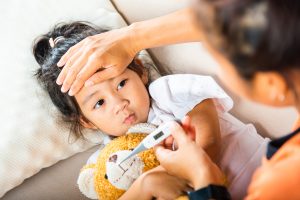 A fever is an above-normal increase in the body’s temperature. A normal body temperature is about 98.6°F. A temperature of 100.4˚ Fahrenheit (38˚ Celsius) or higher is considered a fever for a child. Fevers show the body is fighting off infection from a virus or bacteria. Your child’s body is raising its temperature to kill the germs.
A fever is an above-normal increase in the body’s temperature. A normal body temperature is about 98.6°F. A temperature of 100.4˚ Fahrenheit (38˚ Celsius) or higher is considered a fever for a child. Fevers show the body is fighting off infection from a virus or bacteria. Your child’s body is raising its temperature to kill the germs.
In most cases, fevers are harmless and go away in three days. Signs and symptoms that your child may have a fever include:
- Feels warmer than usual
- Shivering
- Sweating
- General body aches
- Loss of appetite
- Fussiness or irritability
The best way to check your child’s temperature depends on their age. The type of thermometer used to take a temperature may make a difference. Use a digital thermometer. Never use a mercury thermometer. Additionally:
- Rectal thermometers are the most accurate.
- Forehead thermometers are the next best choice if used the right way.
- Oral and ear thermometers can be used if done properly. For oral temperatures, wait 30 minutes after drinking something hot or cold. Wait 15 minutes after coming in from the cold for an ear temperature.
- An axillary or armpit temperature can be used as a quick check but it isn’t very accurate.
A fever may not need to be treated unless your child is uncomfortable. Even higher temperatures are not usually dangerous unless they have a long-term illness. Here are some ways to provide relief and help reduce your child’s fever:
- Dress your child in light clothing. Overdressing them can trap the body’s heat, causing the temperature to rise.
- Make sure they drink lots of fluids. Prolonged fever can lead to dehydration.
- For babies under a year old, continue to give breast milk and formula. They should not be given water. If they are older than six months, give them rehydration liquids that are rich in electrolytes.
- For children over a year old, give them extra liquids, like water, diluted 100% juice, popsicles, or rehydration liquids that are rich in electrolytes.
- Your child may not want to eat much. Give them small amounts of soft foods, but do not force them to eat.
- Give them sponge baths or let them soak in a tub. Water should be lukewarm, not too hot or cold. Use a washcloth to pour the water over them.
- Do NOT add alcohol to the water as it can be dangerous.
- Recheck their temperature 15 minutes after the bath. Repeat the sponge bath if the temperature is 103˚F (39.4˚C) or higher.
- Over-the-counter medicines can help lower a fever. Read the label on the bottle to know the right dose for your child.
- Acetaminophen may be used for all children over two months.
- Ibuprofen may be used for children over six months.
- Do not give aspirin to children.
Call your child’s healthcare provider right away if your child:
- Has a temperature of 104 ˚F (40 ˚C) or above.
- Has a temperature above 102˚F (38.9˚C) for more than 2 days or keeps returning.
- That has been treated to bring it down, but it has not worked.
To speak with a pediatrician at Flushing Hospital Medical Center about your child’s fever, please call 718-670-5440 to schedule an appointment. Please call 911 if there is an emergency.
All content of this newsletter is intended for general information purposes only and is not intended or implied to be a substitute for professional medical advice, diagnosis or treatment. Please consult a medical professional before adopting any of the suggestions on this page. You must never disregard professional medical advice or delay seeking medical treatment based upon any content of this newsletter. PROMPTLY CONSULT YOUR PHYSICIAN OR CALL 911 IF YOU BELIEVE YOU HAVE A MEDICAL EMERGENCY.
